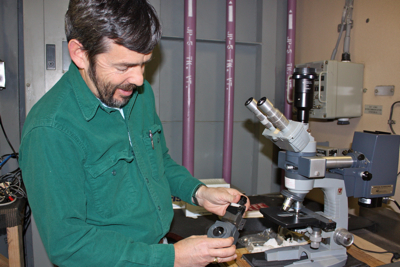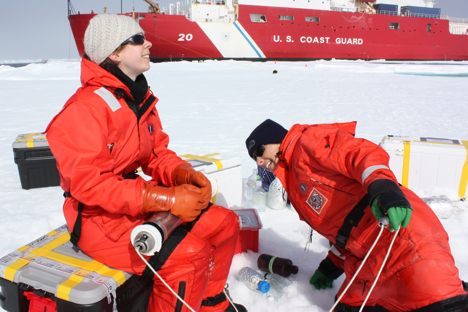July 10, 2011
In the field, resourcefulness is mandatory. Even the most careful planning can’t anticipate every possible complication, whether it’s the breakdown of a tool or a process. Here’s a look at some of the solutions and responses I saw today.
 |
 |
William Balch, of Bigelow Laboratory for Ocean Science, spends evenings in the dark room doing microscopy to find out which species of phytoplankton live in the Arctic Ocean. When the light on his microscope gave out, he crafted a new one out of a flashlight and electrical tape. The device is as good as new! Credit: NASA/Kathryn Hansen

Christie Wood of Clark University (left), and Holly Kelly of Farragut High School (right) appear distressed upon discovering that one of two water samplers had been damaged. Pushing on, they collected water samples today with just one device, doing a little extra math to compensate for mislabeled depth markers. They finished the job within the 3.5 hours allotted for ice stations! Credit: NASA/Kathryn Hansen

Sometimes melt ponds are deeper than they appear. Coast Guard MST2 Owen Dicks paused a moment today to empty ice water from his boots. Credit: NASA/Kathryn Hansen
 |
 |
Underwater cameras are popular this year because they give a close up at what’s going on within and below melt ponds. Once in the field, however, how do you get that camera through a pond and down into the ocean? Chris Polashenki of Cold Regions Research and Engineering Laboratory (left) crafted a device using random scraps of metal, while David Mayer of Clark University (right), affixed his camera to an old mop handle. Credit: NASA/Kathryn Hansen

ICESCAPE scientists watch as a plastic bag, used for storing ice core slices, blows away toward a melt pond. The bag didn’t get far before it was scooped up and returned to its owner. We’re careful to leave no trace other than a few curious holes in the ice. Credit: Chris Polashenski

